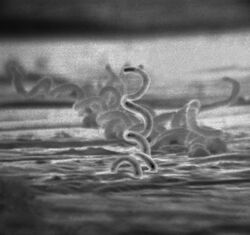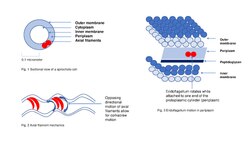Biology:Spirochaete
| Spirochaetes | |
|---|---|

| |
| Treponema pallidum, a spirochaete which causes syphilis | |
| Scientific classification | |
| Domain: | Bacteria |
| Phylum: | Spirochaetota Garrity and Holt 2021[3] |
| Class: | Spirochaetia Paster 2020[1]:471–563[2] |
| Orders | |
| |
| Synonyms | |
| |


A spirochaete (/ˈspaɪroʊˌkiːt/)[4] or spirochete is a member of the phylum Spirochaetota (/-ˈkiːtiːz/), (synonym Spirochaetes) [5] which contains distinctive diderm (double-membrane) gram-negative bacteria, most of which have long, helically coiled (corkscrew-shaped or spiraled, hence the name) cells.[6] Spirochaetes are chemoheterotrophic in nature, with lengths between 3 and 500 μm and diameters around 0.09 to at least 3 μm.[7]
Spirochaetes are distinguished from other bacterial phyla by the location of their flagella, called endoflagella, or periplasmic flagella, which are sometimes called axial filaments.[8][9] Endoflagella are anchored at each end (pole) of the bacterium within the periplasmic space (between the inner and outer membranes) where they project backwards to extend the length of the cell.[10] These cause a twisting motion which allows the spirochaete to move about. When reproducing, a spirochaete will undergo asexual transverse binary fission. Most spirochaetes are free-living and anaerobic, but there are numerous exceptions. Spirochaete bacteria are diverse in their pathogenic capacity and the ecological niches that they inhabit, as well as molecular characteristics including guanine-cytosine content and genome size.[11][12]
Pathogenicity
Many organisms within the Spirochaetota phylum cause prevalent diseases. Pathogenic members of this phylum include the following:
- Leptospira species, which causes leptospirosis[13]
- Borrelia burgdorferi, B. mayonii, B. bissettiae, B. garinii, B. afzelii, B. spielmanii, B. lusitaniae, which cause Lyme disease.[14]
- Borrelia recurrentis, which causes relapsing fever[15]
- Treponema pallidum subspecies which cause treponematoses such as syphilis and yaws.
- Brachyspira pilosicoli and Brachyspira aalborgi, which cause intestinal spirochaetosis[16]
Salvarsan, the first partially organic synthetic antimicrobial drug in medical history, was effective against spirochaetes and primarily used to cure syphilis. Additionally, oral spirochaetes are known to play a significant role in the pathogenesis of human periodontal disease.[17]
Taxonomy and molecular signatures
The class currently consists of 14 validly named genera across 4 orders and 5 families.[18][19][20] The orders Brachyspirales, Brevinematales and Leptospirales each contain a single family, Brachyspiraceae, Brevinemataceae and Leptospiraceae, respectively. The Spirochaetales order harbours two families, Spirochaetaceae and Borreliaceae. Molecular markers in the form of conserved signature indels (CSIs) and CSPs have been found specific for each of the orders, with the exception of Brevinimetales, that provide a reliable means to demarcate these clades from one another within the diverse phylum.[19] Additional CSIs have been found exclusively shared by each family within the Spirochaetales. These molecular markers are in agreement with the observed phylogenetic tree branching of two monophyletic clades within the Spirochaetales order.[19] CSIs have also been found that further differentiate taxonomic groups within the Borreliaceae family that further delineate evolutionary relationships that are in accordance with physical characteristics such as pathogenicity (viz. Borrelia emend. Borreliella gen. nov.).[21] However, this study has been criticized, and other studies using different approaches do not support the proposed split.[22] The new naming system for the Lyme and relapsing fever Borrelia has not been adopted by the scientific literature.[22]
A CSI has also been found exclusively shared by all Spirochaetota species.[19] This CSI is a 3 amino acid insert in the flagellar basal body rod protein FlgC which is an important part of the unique endoflagellar structure shared by Spirochaetota species.[23] Given that the CSI is exclusively shared by members within this phylum, it has been postulated that it may be related to the characteristic flagellar properties observed among Spirochaetota species.[19][23]
Historically, all families belonging to the Spirochaetota phylum were assigned to a single order, the Spirochaetales.[11][12] However, the current taxonomic view is more connotative of accurate evolutionary relationships. The distribution of a CSI is indicative of shared ancestry within the clade for which it is specific. It thus functions as a synapomorphic characteristic, so that the distributions of different CSIs provide the means to identify different orders and families within the phylum and so justify the phylogenetic divisions.[19]
Phylogeny
| 16S rRNA based LTP_08_2023[24][25][26] | 120 single copy marker proteins based GTDB 08-RS214[27][28][29] | ||||||||||||||||||||||||||||||||||||||||||||||||||||||||||||||||||||||||||||||||||||||||||||||||||||||||||||||||||||||||||||||||||||||||||||||||||||||||||||||||||||||||||||||||||||||||||||||||||||||||||||||||||||||||||||||||||||||||||||||||||||||||||||||||||||||||||||||||||||||||||||||||||||||||||||||||||||||||||||||||||||||||||||||||||||||||||||||||||||||||||||||||||||||||||||||||||||||||||||||||||||||||||||||||||||||||||||||||||||||||||||||||||||||||||||||||||||||||||||||||||||||||||||||||||||||||||||||||||||
|---|---|---|---|---|---|---|---|---|---|---|---|---|---|---|---|---|---|---|---|---|---|---|---|---|---|---|---|---|---|---|---|---|---|---|---|---|---|---|---|---|---|---|---|---|---|---|---|---|---|---|---|---|---|---|---|---|---|---|---|---|---|---|---|---|---|---|---|---|---|---|---|---|---|---|---|---|---|---|---|---|---|---|---|---|---|---|---|---|---|---|---|---|---|---|---|---|---|---|---|---|---|---|---|---|---|---|---|---|---|---|---|---|---|---|---|---|---|---|---|---|---|---|---|---|---|---|---|---|---|---|---|---|---|---|---|---|---|---|---|---|---|---|---|---|---|---|---|---|---|---|---|---|---|---|---|---|---|---|---|---|---|---|---|---|---|---|---|---|---|---|---|---|---|---|---|---|---|---|---|---|---|---|---|---|---|---|---|---|---|---|---|---|---|---|---|---|---|---|---|---|---|---|---|---|---|---|---|---|---|---|---|---|---|---|---|---|---|---|---|---|---|---|---|---|---|---|---|---|---|---|---|---|---|---|---|---|---|---|---|---|---|---|---|---|---|---|---|---|---|---|---|---|---|---|---|---|---|---|---|---|---|---|---|---|---|---|---|---|---|---|---|---|---|---|---|---|---|---|---|---|---|---|---|---|---|---|---|---|---|---|---|---|---|---|---|---|---|---|---|---|---|---|---|---|---|---|---|---|---|---|---|---|---|---|---|---|---|---|---|---|---|---|---|---|---|---|---|---|---|---|---|---|---|---|---|---|---|---|---|---|---|---|---|---|---|---|---|---|---|---|---|---|---|---|---|---|---|---|---|---|---|---|---|---|---|---|---|---|---|---|---|---|---|---|---|---|---|---|---|---|---|---|---|---|---|---|---|---|---|---|---|---|---|---|---|---|---|---|---|---|---|---|---|---|---|---|---|---|---|---|---|---|---|---|---|---|---|---|---|---|---|---|---|---|---|---|---|---|---|---|---|---|---|---|---|---|---|---|---|---|---|---|---|---|---|---|---|---|---|---|---|---|---|---|---|---|---|---|---|---|---|---|---|---|---|---|---|---|---|---|---|---|---|---|---|---|---|---|---|---|---|---|---|---|---|---|---|---|---|---|---|---|---|---|---|---|---|---|---|---|---|---|---|---|---|---|---|---|---|---|---|---|---|---|---|---|---|
|
|
Taxonomy
The currently accepted taxonomy is based on the List of Prokaryotic names with Standing in Nomenclature (LPSN)[30] and National Center for Biotechnology Information (NCBI).[31]
- Phylum Spirochaetota Garrity and Holt 2021
- Class Spirochaetia Paster 2020
- Genus ?"Spirosymplokos" Guerrero et al. 1993
- Order Leptospirales Gupta et al. 2014
- Family Leptospiraceae Hovind-Hougen 1979
- Genus Leptonema Hovind-Hougen 1983
- Genus Leptospira Noguchi 1917
- Genus Turneriella Levett et al. 2005
- Family Leptospiraceae Hovind-Hougen 1979
- Order Brachyspirales corrig. Gupta et al. 2014
- Family Brachyspiraceae Paster 2012
- Genus Brachyspira Hovind-Hougen et al. 1982
- Genus ?"Ca. Maribrachyspira" Matsuyama et al. 2017
- Family Brachyspiraceae Paster 2012
- Order Brevinematales Gupta et al. 2014
- Family Brevinemataceae Paster 2012
- Genus Brevinema Defosse et al. 1995
- Family "Longinemaceae" Karnachuk et al. 2021
- Genus ?"Longinema" Karnachuk et al. 2021
- Family "Thermospiraceae" Ben Ali Gam et al. 2023
- Genus Thermospira Ben Ali Gam et al. 2023
- Family Brevinemataceae Paster 2012
- Order "Exilispirales" Pallen, Rodriguez-R & Alikhan 2022
- Family "Exilispiraceae" Pallen, Rodriguez-R & Alikhan 2022
- Genus Exilispira Imachi et al. 2008
- Family "Exilispiraceae" Pallen, Rodriguez-R & Alikhan 2022
- Order Spirochaetales Buchanan 1917 ["Entomospirales" Pallen, Rodriguez-R & Alikhan 2022; "Marispirochaetales" Pallen, Rodriguez-R & Alikhan 2022; "Salinispirales" Pallen, Rodriguez-R & Alikhan 2022; "Sediminispirochaetales" Pallen, Rodriguez-R & Alikhan 2022]
- Family "Pillotinaceae" Margulis & Hinkle 1992
- Genus ?Pillotina Hollande and Gharagozlou 1967 ex Bermudes et al. 1988
- Family Borreliaceae Gupta et al. 2014
- Genus Borrelia Swellengrebel 1907 (relapsing fever Borrelia, reptile-associated Borrelia and Echidna-associated Borrelia)
- Genus Borreliella Adeolu & Gupta 2015 (Lyme disease Borrelia)
- Genus ?Cristispira Gross 1910
- Family Sphaerochaetaceae Hördt et al. 2020
- Genus Bullifex Wylensek et al. 2021 [incl. "Ca. Aphodenecus" Gilroy et al. 2021]
- Genus "Ca. Ornithospirochaeta" Gilroy et al. 2021
- Genus Parasphaerochaeta Bidzhieva et al. 2020
- Genus "Ca. Physcosoma" Gilroy et al. 2022
- Genus Pleomorphochaeta Arroua et al. 2016
- Genus Sphaerochaeta Ritalahti et al. 2012
- Family Spirochaetaceae Swellengrebel 1907 ["Entomospiraceae" Pallen, Rodriguez-R & Alikhan 2022; "Marispirochaetaceae" Pallen, Rodriguez-R & Alikhan 2022; "Salinispiraceae" Pallen, Rodriguez-R & Alikhan 2022; "Sediminispirochaetaceae" Pallen, Rodriguez-R & Alikhan 2022; "Thiospirochaetaceae" Pallen, Rodriguez-R & Alikhan 2022]
- Genus ?"Ca. Allospironema" Paster & Dewhirst 2000
- Genus ?"Canaleparolina" Wier, Ashen & Margulis 2000
- Genus ?Clevelandina Bermudes et al. 1988
- Genus ?Diplocalyx Gharagozlou 1968 ex Bermudes et al. 1988 non Richard 1850 non Presl 1845
- Genus ?Hollandina To et al. 1978 ex Bermudes et al. 1988 non Haynes 1956
- Genus ?"Mobilifilum" Margulis et al. 1990
- Genus Alkalispirochaeta Sravanthi et al. 2016
- Genus "Entomospira" Grana-Miraglia et al. 2020 non Enderlein 1917
- Genus Marispirochaeta Shivani et al. 2017
- Genus Oceanispirochaeta Subhash & Lee 2017b
- Genus Salinispira Ben Hania et al. 2015
- Genus Sediminispirochaeta Shivani et al. 2016
- Genus Spirochaeta Ehrenberg 1835 em. Pikuta et al. 2009 non Turczaninow 1851
- Genus Thiospirochaeta Dubinina et al. 2020
- Family "Pillotinaceae" Margulis & Hinkle 1992
- Order "Treponematales" Song et al. 2021
- Family Breznakiellaceae Brune et al. 2022
- Genus Breznakiella Song et al. 2022
- Genus Gracilinema Brune et al. 2022
- Genus Helmutkoenigia Brune et al. 2022
- Genus Leadbettera Brune et al. 2022
- Genus Zuelzera Brune et al. 2022
- Family "Rectinemataceae" Song et al. 2021
- Genus Rectinema Koelschbach et al. 2017
- Family Treponemataceae Robinson 1948
- Genus "Ca. Avitreponema" Gilroy et al. 2021
- Genus "Brucepastera" Song et al. 2022
- Genus "Ca. Gallitreponema" Gilroy et al. 2021
- Genus "Teretinema" Song et al. 2022
- Genus Treponema Schaudinn 1905 em. Abt et al. 2013
- Family Breznakiellaceae Brune et al. 2022
- Class Spirochaetia Paster 2020
See also
- List of bacteria genera
- List of bacterial orders
- Bacteriology
- Borrelia
- Brevinema andersonii
- Flagellum
- Lyme disease microbiology
- Pinta (disease)
- Prokaryote
- Syphilis
- Treponema pallidum
- Yaws
References
- ↑ "Class I. Spirochaetia class. nov.". Bergey's Manual of Systematic Bacteriology. 4—The Bacteroidetes, Spirochaetes, Tenericutes (Mollicutes), Acidobacteria, Fibrobacteres, Fusobacteria, Dictyoglomi, Gemmatimonadetes, Lentisphaerae, Verrucomicrobia, Chlamydiae, and Planctomycetes (2nd ed.). New York, NY: Springer. 2010. doi:10.1007/978-0-387-68572-4. ISBN 978-0-387-95042-6.
- ↑ "Validation list no. 195. List of new names and new combinations previously effectively, but not validly, published". Int J Syst Evol Microbiol 70 (9): 4844–4847. 2020. doi:10.1099/ijsem.0.004366. PMID 32993851.
- ↑ "Valid publication of the names of forty-two phyla of prokaryotes". Int J Syst Evol Microbiol 71 (10): 5056. 2021. doi:10.1099/ijsem.0.005056. PMID 34694987.
- ↑ "SPIROCHAETE | Meaning & Definition for UK English | Lexico.com". https://www.lexico.com/definition/spirochaete.
- ↑ Dorland's Illustrated Medical Dictionary. Elsevier. http://dorlands.com/.
- ↑ Sherris Medical Microbiology (4th ed.). McGraw Hill. 2004. ISBN 978-0-8385-8529-0.
- ↑ "Composite, large spirochetes from microbial mats: spirochete structure review". Proceedings of the National Academy of Sciences of the United States of America 90 (15): 6966–6970. August 1993. doi:10.1073/pnas.90.15.6966. PMID 8346204. Bibcode: 1993PNAS...90.6966M.
- ↑ "Spirochete Flagella and Motility". Biomolecules 10 (4): 550. April 2020. doi:10.3390/biom10040550. PMID 32260454.
- ↑ "Spirochetes and Other Spiral Microorganisms". McGraw-Hill Education. 2019. https://accessmedicine.mhmedical.com/content.aspx?bookid=1551§ionid=94107920.
- ↑ Brock biology of microorganisms (Fifteenth, Global ed.). NY, NY: Pearson. 2019. p. 519. ISBN 9781292235103.
- ↑ 11.0 11.1 "Phylum XV. Spirochaetes Garrity and Holt.". Bergey's Manual of Systematic Bacteriology. New York: Springer. 2011. pp. 471.
- ↑ 12.0 12.1 "Family I. Sprochaetes Swellengrebel 1907, 581AL.". Bergey's Manual of Systematic Bacteriology. New York: Springer. 2011. pp. 473–531.
- ↑ "Leptospirosis". Current Opinion in Infectious Diseases 18 (5): 376–86. 2005. doi:10.1097/01.qco.0000178824.05715.2c. PMID 16148523.
- ↑ "Host association of Borrelia burgdorferi sensu lato: A review". Ticks and Tick-Borne Diseases 12 (5): 101766. September 2021. doi:10.1016/j.ttbdis.2021.101766. PMID 34161868.
- ↑ "Ticks and Borrelia: model systems for investigating pathogen-arthropod interactions". Infectious Agents and Disease 5 (3): 167–181. June 1996. PMID 8805079.
- ↑ "[Colonic spirochetes: an infrequent cause of adult diarrhea]" (in es). Gastroenterol Hepatol 27 (1): 21–3. January 2004. doi:10.1016/s0210-5705(03)70440-3. PMID 14718105.
- ↑ "Oral spirochetes: Pathogenic mechanisms in periodontal disease". Microbial Pathogenesis 144: 104193. July 2020. doi:10.1016/j.micpath.2020.104193. PMID 32304795.
- ↑ "TherSpirochaetia". National Center for Biotechnology Information (NCBI) taxonomy database. https://www.ncbi.nlm.nih.gov/Taxonomy/Browser/wwwtax.cgi?mode=Undef&id=203692&lvl=3&p=mapview&p=has_linkout&p=blast_url&p=genome_blast&lin=f&keep=1&srchmode=1&unlock.
- ↑ 19.0 19.1 19.2 19.3 19.4 19.5 "A phylogenomic and molecular signature based approach for characterization of the phylum Spirochaetes and its major clades: proposal for a taxonomic revision of the phylum". Front Microbiol 4 (217): 217. 2013. doi:10.3389/fmicb.2013.00217. PMID 23908650.
- ↑ "List of new names and new combinations previously effectively, but not validly, published". Int. J. Syst. Evol. Microbiol. 64 (3): 693–696. 2014. doi:10.1099/ijs.0.062521-0. http://www.microbiologyresearch.org/docserver/fulltext/ijsem/64/3/693_ijs062521.pdf?expires=1477417542&id=id&accname=guest&checksum=2C44BCAA8040751280AC24CAF29DC185.
- ↑ "A phylogenomic and molecular marker based proposal for the division of the genus Borrelia into two genera: the emended genus Borrelia containing only the members of the relapsing fever Borrelia, and the genus Borreliella gen. nov. containing the members of the Lyme disease Borrelia (Borrelia burgdorferi sensu lato complex)". Antonie van Leeuwenhoek 105 (6): 1049–1072. 2014. doi:10.1007/s10482-014-0164-x. PMID 24744012.
- ↑ 22.0 22.1 "Recent discoveries and advancements in research on the Lyme disease spirochete Borrelia burgdorferi". F1000Research 8: 763. 2019. doi:10.12688/f1000research.18379.1. PMID 31214329.
- ↑ 23.0 23.1 "How bacteria assemble flagella". Annu Rev Microbiol 57: 77–100. 2003. doi:10.1146/annurev.micro.57.030502.090832. PMID 12730325.
- ↑ "The LTP". https://imedea.uib-csic.es/mmg/ltp/#LTP.
- ↑ "LTP_all tree in newick format". https://imedea.uib-csic.es/mmg/ltp/wp-content/uploads/ltp/LTP_all_08_2023.ntree.
- ↑ "LTP_08_2023 Release Notes". https://imedea.uib-csic.es/mmg/ltp/wp-content/uploads/ltp/LTP_08_2023_release_notes.pdf.
- ↑ "GTDB release 08-RS214". https://gtdb.ecogenomic.org/about#4%7C.
- ↑ "bac120_r214.sp_label". https://data.gtdb.ecogenomic.org/releases/release214/214.0/auxillary_files/bac120_r214.sp_labels.tree.
- ↑ "Taxon History". https://gtdb.ecogenomic.org/taxon_history/.
- ↑ "Spirochaetes". List of Prokaryotic names with Standing in Nomenclature (LPSN). http://www.bacterio.net/-classifphyla.html#SpirochaetesorSpirochaetae.
- ↑ "Spirochaetes". National Center for Biotechnology Information (NCBI) taxonomy database. https://www.ncbi.nlm.nih.gov/Taxonomy/Browser/wwwtax.cgi?mode=Undef&id=203691&lvl=6&lin.
External links
- Introduction to the Spirochetes University of California Museum of Paleontology (UCMP)
Wikidata ☰ Q12673555 entry
 |
